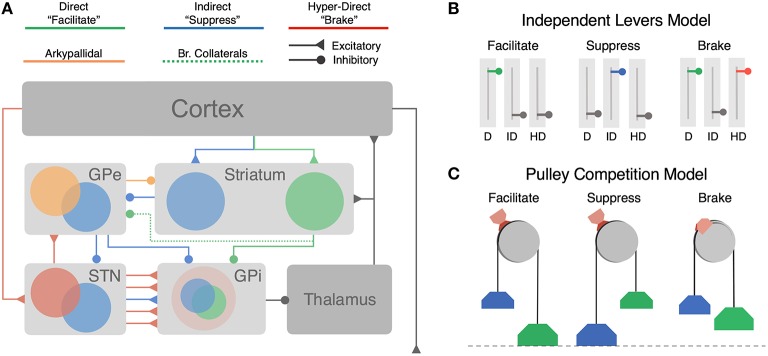Figure 1.
Architecture of cortico-BG pathways and hypothesized functional models. (A) Cortico-BG pathways including three major inputs to the striatal direct (green), indirect (blue) pathways, and the subthalamic hyper-direct (red) pathway. Bridging collaterals (green, dotted) connect the direct pathway to the indirect pathway via projections to the GPe. The arkypallidal pathway (orange) sends inhibitory feedback projections from the GPe to the striatum. Both the direct pathway (cortex-striatum-GPi) and “short” indirect pathway (cortex-striatum-GPe-GPi) form focused projections throughout the network corresponding to individual action channels. The “long” indirect pathway (cortex-striatum-GPe-STN-GPi) and hyper-direct pathway (cortex-STN-GPi) deliver diffuse excitatory inputs to the output nucleus. (B) Independent Levers Model (i.e., the canonical model) assumes that the direct (left, green), indirect (middle, blue), and hyper-direct (right, red) pathways are structurally and functionally segregated. Each pathway is operated in isolation for facilitating, suppressing, or braking motor output in the BG. (C) Pulley Competition Model (i.e., Believer-Skeptic) assumes that the direct and indirect pathways compete throughout the BG (see Section Introduction), with the strength of each pathway acting as weights on opposing sides of a pulley. As activation in the direct pathway overpowers that of the indirect pathway, this imbalance accelerates the network toward “facilitation,” resulting in an executed action when the difference reaches a critical threshold (dotted line). In the event of a stop cue, the action can be reactively canceled if the pulley brake (red brake pad) is activated before the direct-indirect difference reaches a critical threshold. The accelerating (e.g., nonlinear) dynamics of an imbalanced pulley lead to less efficacious braking when the network is pulled further toward action execution (e.g., longer brake streaks on pulley wheel). This dependency illustrates how proactive modulation of the direct-indirect balance may influence reactive stopping via activation of the hyper-direct pathway.

